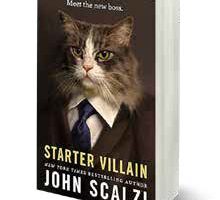Thirty-five years is a long time to hate, but that hasn’t stopped Charles Baker. Now, the time is finally right. He’ll get revenge on those two white boys who started the trouble all those years ago. They owe him. On the other side of town, Alex Pappas runs his family’s coffee shop. His face still bears the scars, a physical testament to his own stupidity, but Pappas isn’t seeking revenge; instead, he desperately yearns for redemption.”Write what you know,” authors are told. Writers often ignore this advice while attempting to create stories about exotic places, but the pulse of an environment can only be captured by those who experience it first-hand. George Pelecanos knows that. “The Turnaround” is Pelecanos’ 15th crime novel set in and around Washington D.C.Born in 1957, he witnessed the racial tensions that ravaged big-city America during the 1970s. He draws on a lifetime of practical knowledge to recreate the bigotry found in the white working class neighborhood in which he grew up. The grit and grime of his D.C. suburb ooze out of the pages. He captures the closed-minded mentality of its inhabitants to such an extent that it almost suffocates the reader. But before it does, the reader is already hooked because Pelecanos’ strongest writing strength is character development. Within a few pages, I have to know the fate of Pappas, Baker and the two Monroe brothers whose lives were irrevocably changed on a hot August night in 1972. Billy Cachoris, Pete Whitten and Alex Pappas, three bored teenagers hopped up on beer and pot, were cruising town looking for a bit of fun. On the other side of the tracks, a group of black teenagers gathered on the sidewalk trying to escape the stifling heat of their apartment buildings. It was Billy’s idea to venture into “Nee-grow Heights,” the racial slur his father used for the black section of town, actually called Heathrow Heights. None of them had ever been there, even though the Heights was a few blocks from their homes, but this little jaunt would give them something to brag about when they returned to school in September.Billy slowed the Toreno, as Pete reached into a bag and retrieved a Hostess cherry pie. He quickly tosses it into the face of the closest black teenager. While screaming the infamous racial epithet, Billy laid rubber, Pete laughed and Alex sunk lower into the back seat, as the trio attempted to make a quick getaway. Alex’s drug-induced fog was wearing off and he knew his parents would be ashamed of him. Choices made as teenagers often change the course of lives forever; this one certainly did.Once executed, there was no escape, no “Turnaround,” only a dead end. Safety could not be reached without retracing their route, leading them right back to the now angry crowd of black males. Pete jumps out of the car and runs. Billy attempts to appease the mob with an apology while yelling at Alex to “take off.” But it’s too late. Alex is pushed to the ground and the last thing he remembers is Baker’s foot coming down on his skull just as a shot rings out. Their joyride resulted in Cachoris’ death, Pappas’ disfigurement and jail time for Baker and James Monroe.Don’t worry readers: I haven’t given away the entire plot. That’s just where Pelecanos gets started. He uses the flashback technique to smoothly transition between the 1970s and the present. While fictional, this pivotal scene sounds familiar to anyone who lived through the same time period. Readers shouldn’t expect Pelecanos to deliver a politically correct or bleeding heart rendition of past or current race relations. The language used in this book makes quoting passages in a newspaper review impossible. It’s the language of the streets, and Pelecanos writes about life as it is, not as we would like it to be. He knows the line between “good” and “evil” is often based on your perspective, and that people of every race are capable of both, given the circumstances.Pelecanos reconnects the characters after 35 years, with a chance encounter between Pappas and Raymond Monroe, James’ younger brother, at Walter Reed Army Medical Center. While Baker’s revenge plot adds suspense to the novel, the relationship that grows between the Monroe brothers and Pappas becomes the central theme of the story. It gives readers just a glimmer of hope that race relations between blacks and whites may have improved over the decades.The only flaw I find in “The Turnaround” is Pelecanos’ development of a sub-plot mystery that was too easy to solve. I prefer to be kept guessing until the end of the book, but Pelecanos delivers a realistic story with well-developed characters – which makes up for that deficit. “The Turnaround” encapsulates life in suburban Washington D.C. both then and now. It’s not a pretty picture, and that’s what makes this fictional crime novel ring true.Note: Next month, I’ll review “Hot, Flat, and Crowded,” by Thomas L. Friedman. Read the book then read my review. Send your comments to KathyH@newfalconherald.com.






